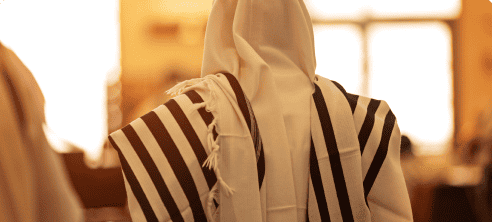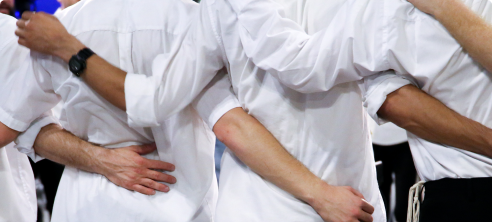
יום כיפור
Yom Kippur
The Jewish day of Atonement
י’ תשרי / October 12, 2024

WHAT IS YOM KIPPUR?
The Jewish calendar abounds with auspicious times for different things. Atonement is one of man’s most significant spiritual endeavors, but it is especially favorable on Yom Kippur Day. We can be forgiven for sins throughout the year if we repent with a sincere heart. Still, on Yom Kippur, the gates of repentance are flung wide open, and Hashem eagerly awaits to forgive us if only we take the initiative.
When the Beis Hamikdash stood, Yom Kippur was a special day that included many unique practices recorded at length in Sefer Vayikra. These activities brought down atonement from on high, but today, we are left without the Beis Hamikdash. Rambam stresses that nowadays, there is nothing other than repentance. However, the day of Yom Kippur also provides forgiveness. This is based on the verse, “כי ביום הזה יכפר עליכם לטהר אתכם מכל חטאתיכם לפני ה’ תטהרו…for on this day He will atone for you to purify you all, from all your sins before Hashem you shall be purified.” We learn that it is the day that provides attornment. Still, that additional injection of atonement requires a repentant heart. If Yom Kippur is utilized for introspection and repentance, the result of that soul-searching, combined with the cleansing agent of Yom Kippur, will produce a clean slate.

כי ביום הזה יכפר עליכם… also teaches us another vital element of repentance. Note the words מכל חטאתיכם לפני from all your sins before Hashem. Sins that are before Hashem are those that are between man and G-d. These are cleansed through repentance and the day of Yom Kippur. However, sins between man and man require something else. First, the offended party must forgive, then the sinner can expect attornment from on high.
In Jewish history, Yom Kippur was when Hashem announced to Moshe סלחתי – I forgive you. Moshe had ascended the mountain and pleaded for the Jewish nation for forty days because of the sin of the חטא העגל – Golden Calf. On Yom Kippur, the Jewish nation received forgiveness, and on Yom Kippur, they receive forgiveness anew yearly.
Preparing For The Holy Day
Yom Kippur is designated for forgiveness and is the climax of the עשרת ימי תשובה – Ten Days of Repentance. It is cause for confident joy in Hashem’s mercy and forgiveness but also requires reflective preparation. The books will be sealed on Yom Kippur, and our destiny will be confirmed. If we ready ourselves properly, we can rest assured that Hashem will be there. Traditionally, there are many activities that we engage in during the days leading up to Yom Kippur. Selichos are recited throughout the Aseres Yemei Teshuva, and charity is distributed to people experiencing poverty.
It is important to add good deeds between the days of Rosh Hashanah and Yom Kippur. Everyone’s good and bad deeds are weighed in heaven, determining which book they will be inscribed in. All mitzvos, but particularly teshuvah – repentance, tefillah – prayer, and tzedakah – charity, have the potential to tip the scales.

ARE YOU PREPARED FOR YOM KIPPUR – A Day of Forgiveness?
Give Tzedakah as a merit for a Good Year
עשרת ימי תשובה- Aseres Yemei Teshuva
The first day of Rosh Hashana is the first of the עשרת ימי תשובה -Ten Days of Repentance, and Yom Kippur is the last. The ancients taught that during these ten days, Teshuvah (repentance), Tefilah (prayer), and Tzedakah (charity) are incredibly effective and more readily accepted in heaven.
Everyone should take these precious days seriously and maximize them for their total worth.


Tzedakah
Charity is one of the three activities mentioned in the davening of Yom Kippur that removes an evil decree. Halachic sources discuss the custom of giving charity to people experiencing poverty on both Erev Rosh Hashanah and Erev Yom Kippur.
Throughout the Ten Days of Repentance, we strive to add good deeds, and Tzedakah is one of the most significant mitzvos a Jew can do. Hashem will surely take note if we come to the aid of people in need.

“תשובה תפילה וצדקה מעבירין את רוע הגזירה”
“Repentance, prayers, and charity destroy evil decrees.”
Kaparos
Kaparos is an ancient custom that can be performed anytime between Rosh Hashanah and Yom Kippur, but some people delay until Erev Yom Kippur. This ancient ritual is accomplished by revolving a chicken around one’s head while reciting a tefillah – a prayer that says the rooster will be slaughtered and the individual will proceed to a good, long life.
The concept resembles Tashlich, where sins are symbolically thrown into the watery depths. Here, too, we symbolically remove our sins and place them elsewhere to urge ourselves toward repentance.
While many people use a chicken, others use money. These people wave charity money around their heads and recite a text stating that this money will go to charity and they will have a long life. There is also a custom to use a fish.


Erev Yom Kippur
Erev Yom Kippur is a particularly special day. Not only is it a day of preparation for a holiday, but it is also a holiday itself. There is a special requirement to partake in a festive meal. While the Torah requires us to fast, it also wants us to celebrate this holy day and to prepare ourselves physically for the fast day. Just as fasting on Yom Kippur is a Mitzvah, so is eating on Erev Yom Kippur. It is a fearful time due to the impending day of Yom Kippur, but also a pleasurable one due to our anticipation for forgiveness.
There is a custom to eat two meals on Erev Yom Kippur. Eating fish at the first meal is customary, and some people put “kreplach” in their soup. Kreplach is a dough dumpling filled with meat, and it symbolizes our desire to be granted a year filled with good things. The second meal is called the Seudah Hamafsekes when the last food is eaten before the onset of Yom Kippur. It is customary to serve light rather than heavy foods. Also, salty and spicy foods are generally avoided.

What We Do On Yom Kippur?
Yom Kippur is the only day entirely dedicated to prayer. For one day, we emulate the angels, abstaining from bodily desires, which gives way to spiritual introspection. We reflect on our imperfections and resolve to mend our ways. Traditionally, Yom Kippur has been one of the happiest days of the year because we are forgiven and begin anew with a clean slate.
On Yom Kippur we may not:

eat

drink

bathe, or smear

wear leather shoes

engage in marital relations
Yom Kippur is the one day a year we strive to be like angels. We separate ourselves from our physical needs for a short time, focusing only on spiritual and lofty matters. This is one reason married men wear a Kittel – a special white garment – on Yom Kippur Day – to remind us that on this day, we are pure like angels. Many women also wear white clothes for the same reason. We also refrain from wearing gold because it recalls the sin of the golden calf. We want to put our best foot forward, and anything that is remindful of sin is to be avoided.
yom kippur Prayers
Yom Kippur centers around atonement, and as such, we spend a lot of time praying for repentance and listing off the actual sins we performed. In the Alcoholics Anonymous program, the first step toward recovery is admission. If a person doesn’t admit to the fact that they have an addictive problem, they can’t possibly be helped. No matter what actions are taken, the individual will remain in denial. The same is true of Teshuva (repentance). The first step toward atonement is admission. We must own up to our problems and the fact that we messed up. Once we declare and enumerate our sins, the next step is to resolve them. We need to commit to not repeating the offense. Once that is complete, we can expect atonement.
Yom Kippur and repentance are cleansing agents that clean our slates – but this only applies to sins between man and G-d. Yom Kippur does not erase sins between man and man so long as that person does not receive forgiveness. Therefore, asking “mechila” forgiveness from people we wronged during the Ten Days of Repentance is very important.
Forgiving others for their sins is a good idea, even if they do not ask us for forgiveness. In fact, Tefillah Zakkah, a prayer customarily recited before Kol Nidrei, includes a paragraph that states that one forgives others. One who finds it within themselves to forgive and forget can expect forgiveness from on high, while one who holds onto feelings of resentment and hate is less likely to receive forgiveness.

KOL NIDREI – כל נדרי
Yom Kippur begins with a unique prayer that is a declaration known as Kol Nidrei. But before Kol Nidrei is recited, the Chazzan chants a prayer that states that both up in heaven as well as down here on earth, everyone is invited to participate, even transgressors who may have been excluded from the synagogue throughout the year.
This teaches that even one who managed to cut himself off from his spiritual life source is salvageable through the power of sincere repentance.
Then comes the thrice-repeated declaration of Kol Nidrei. This paragraph, which begins at a low volume and becomes increasingly louder with each repetition, is chanted by the Chazzan and the congregation. At the same time, a “bais din” of three people stands near the Chazzan at the front of the synagogue holding Torah scrolls. This prayer declares that any vows or promises of our own will be annulled.
Various forms of oaths are enumerated, including vows, consecrations, and more. After this prayer, the Men holding the Torah scrolls circle the shul, and everyone kisses the Torah scrolls. It is important to remember that the Kol Nidrei prayer only refers to those oaths that we took “al nafshana” – on ourselves. However, the vow between us and others cannot be absolved through Kol Nidrei.

KRIAS SHEMA -קריאת שמע
When we recite the Shema on Yom Kippur, we read Baruch Shem Kivod aloud and in unison. These are words that the angels exclaim in heaven, and we recite them in a whisper during the year. Yom Kippur, however, is different because it is when our sins are forgiven. As such, we feel confident enough to recite out loud that which the angles exclaim on high.

VIDUI – ווידוי
This is the formal confession prayer repeated ten times throughout Yom Kippur and once on Erev Yom Kippur at Mincha. Vidui includes:
אשמנו
We recite a litany of confessions alphabetically, striking the chest lightly at each mention. While it does not enumerate specific sins, mentioning one’s sins in the appropriate letter is good practice. For instance, if one ate a prohibited food, he might say “על חטא דבר אסור” – I ate something prohibited after reciting “Ashamnu” since those words also begin with the letter Aleph. Each sin should be placed in its appropriate place.
על חטא
This is a much more detailed confession that begs forgiveness for specific sins. When reading this confession, one should think about past wrongs and repent from sins that pertain to each confession. Note that the tenth and final Vidui recited during Chazaras Hashatz of Neilah includes only Ashamnu and not Al Chait. The other nine and the Vidui recited on Erev Yom Kippur include both.

TORAH READINGS OF YOM KIPPUR
For the Shachris Torah Reading, we read from Parshas Acherei Mos about the commandments and details of the service in the Beis Hamikdash on Yom Kippur. This includes throwing the lots, casting the Azazel, and entering the Kohen Gadol into the Kodesh HaKodashim – Holy of Holies. For Maftir, we read from Parshas Pinchas about the sacrifices to this day.
For the Mincha Torah Reading, we read the second part of Parshas Acherei Mos, which lists the forbidden relationships. Discipline is vital for a servant of Hashem. While repentance on Yom Kippur includes all sins, these sins are stressed here as men are subject to strong passions occasionally. This, in turn, causes men to lose their innate holiness and is particularly harmful. The Torah reading helps people to reflect on their errors and to rectify any mistakes. The Torah prefaces this list of sins with a paragraph that begins with the words “I am Hashem, your G-d.” The Meshech Chachmah writes that before instructing us with a list of forbidden relationships, Hashem tells us that if He forbade these relationships, then we can be sure that we can control our desires because Hashem created us, and He knows our limitations. No prohibition is too hard to overcome. Hashem instructed us on how best to live. It is very unfortunate when men misuse the gift of their bodies. Conversely, one who lives a life guided by morality will have persevered in his innate holiness and be granted blessings from on high.

AVODAH – MUSAF עבודה / מוסף
When the Bais HaMikdash stood, the Kohen Gadol was the messenger of the people who pleaded forgiveness for his nation. Today, we are missing those grand ceremonies and prayer that takes place. Therefore, as part of the Yom Kippur service, there is a lengthy and detailed description of the Avodah conducted during the Bais Hamikdosh. We act out some parts of the service, such as bowing.
We bow down to the floor once during the recital of עלינו and three times during the description of the Avodah in the Beis Hamikdash. When we reach the point in the narrative where the Kohanim and the people in the courtyard of the Beis Hamikdash prostrate themselves on the floor upon hearing the glorious Name of Hashem emanating from the mouth of the Kohen Gadol, we, too, bow down on the floor to Hashem. Note that the Torah forbids prostrating oneself completely on a floor of stone. The Sages forbade complete prostration on non-stone floors and even kneeling (partial prostration) on stone floors. Therefore, if the synagogue floor is stone, one must put down something before bowing. While this doesn’t apply to non-stone floors, there are customs to putting something down regardless.

HAFTORAH OF YONAH – הפטרה / יונה
The Haftorah of Mincha includes the entire book of Yonah, which teaches about the power of repentance. The classic story of Teshuva is that of Sefer Yonah. Some of the themes of this story are:
1. Yonah attempts to flee from Hashem – but one cannot escape because Hashem’s presence is everywhere.
2. Ninveh takes responsibility for their actions, pulling apart their homes to return the stolen bricks.
3. The Kikayon plant, which causes Yonah great distress when it dies and stops providing shade, demonstrates that Hashem doesn’t want to destroy humanity, including wicked people. Hashem wants humankind to repent and live moral and upstanding lives.

NEILAH – נעילה
The fifth and final prayer segment of Yom Kippur is Neilah, which means “locking” because the gates of Heaven are closing. From the onset of judgment, the Heavenly Court provides open access. Man pleads his case, begs for mercy, repents, and draws near. As the day ends, the window of opportunity begins to shut. Smart people grab the last moments of their appeal and exert themselves in sincere prayer and repentance. It is the final opportunity of the holiest day of the year. During this time, one should attempt to bring oneself to tears to arouse heavenly mercy.
After Neilah, the shofar is blown, and we exclaim, “לשנה הבא בירושלים – Next Year in Yerushalayim.”

MOTZEI YOM KIPPUR
When Yom Kippur is over, we make Havdalah and sit down to a meal. We are confident that we have done our part and attained atonement. We also try to begin right away with a Mitzvah. It is customary to recite Kiddush Levana after Maariv, and many people start building their Succah on Motzei Yom Kippur.
The verse in Tehillim states, סור מרע,ועשה טוב – Turn from wrong and do good. We get busy doing good after getting rid of the bad in our lives. Even doing nothing is no good because it leads to evil. By getting busy doing good, we ensure we are on the path we eagerly prayed for on Yom Kippur. May this year be one of only good decrees stamped on Rosh Hashanah and sealed on Yom Kippur. May we all merit a clean slate filled with abundant good deeds for this coming year and beyond.

SEAL THE DEAL FOR A GOOD YEAR

YOM KIPPUR IN BELZ
Take a journey to Belz with images from some of the most memorable
moments with the Rebbe during these holy days.
Inspirational Yom Kippur Stories

INSPIRE YOUR INBOX.
Enjoy a weekly dose of Chassidic insights, highlights and happenings at Belz.








